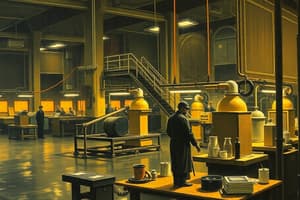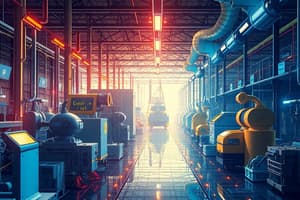Podcast
Questions and Answers
What is the primary function of a Normally Open (NO) switch?
What is the primary function of a Normally Open (NO) switch?
- It prevents current from flowing when activated.
- It allows current to flow when not activated.
- It prevents current from flowing when not activated.
- It allows current to flow when activated. (correct)
Which scenario best illustrates the use of a Normally Closed (NC) switch?
Which scenario best illustrates the use of a Normally Closed (NC) switch?
- Triggering an alarm when a door is opened. (correct)
- Deactivating a sensor-based alarm at all times.
- Starting a motor when a start button is pressed.
- Turning on a light when someone presses a button.
What role do flags play in a PLC program?
What role do flags play in a PLC program?
- They are used to control physical outputs directly.
- They are employed for emergency stop functions.
- They execute timing functions for automated processes.
- They maintain the state based on prior conditions. (correct)
Which of the following is a function of a holding circuit?
Which of the following is a function of a holding circuit?
In ladder programming, what determines the output activation?
In ladder programming, what determines the output activation?
What is the primary purpose of a Programmable Logic Controller (PLC)?
What is the primary purpose of a Programmable Logic Controller (PLC)?
Which of the following features does the Siemens 'Logo!' PLC offer?
Which of the following features does the Siemens 'Logo!' PLC offer?
In what type of applications is the Siemens 'Logo!' PLC most suitable?
In what type of applications is the Siemens 'Logo!' PLC most suitable?
What benefit does the real-time event handling feature of a PLC provide?
What benefit does the real-time event handling feature of a PLC provide?
Which of the following best describes the intended users of the Siemens 'Logo!' PLC?
Which of the following best describes the intended users of the Siemens 'Logo!' PLC?
What is the primary purpose of versioning in web services?
What is the primary purpose of versioning in web services?
Which level of the Richardson REST Maturity Model is characterized by the use of hypermedia links?
Which level of the Richardson REST Maturity Model is characterized by the use of hypermedia links?
What is the main function of WSDL in web services?
What is the main function of WSDL in web services?
What does SOAP primarily use for message format?
What does SOAP primarily use for message format?
What is a characteristic of XML?
What is a characteristic of XML?
Which level of the Richardson REST Maturity Model allows full utilization of HTTP methods?
Which level of the Richardson REST Maturity Model allows full utilization of HTTP methods?
What does XSD validate?
What does XSD validate?
What is the fundamental role of error-checking in data delivery?
What is the fundamental role of error-checking in data delivery?
What does stability in a control system refer to?
What does stability in a control system refer to?
What does a positive offset indicate in a control system?
What does a positive offset indicate in a control system?
What is the primary function of the differential element in differential two-position control?
What is the primary function of the differential element in differential two-position control?
In which scenario would integral control be particularly useful?
In which scenario would integral control be particularly useful?
Which aspect of control loop response does the interaction between sensors, controllers, and controlled devices primarily influence?
Which aspect of control loop response does the interaction between sensors, controllers, and controlled devices primarily influence?
What is a characteristic of the neutral zone in a tri-state device?
What is a characteristic of the neutral zone in a tri-state device?
Which of the following best describes the derivative control strategy?
Which of the following best describes the derivative control strategy?
Flashcards
What is a PLC?
What is a PLC?
A specialized computer used for controlling machinery and processes in real-time. It combines multiple inputs (sensors) and outputs (actuators) for automation.
Siemens "Logo!" PLC
Siemens "Logo!" PLC
Siemens "Logo!" is a small and easy-to-use PLC perfect for smaller automation tasks, like controlling lighting or simple machinery.
Real-time Event Handling
Real-time Event Handling
A PLC can process information from sensors and make decisions instantly, controlling outputs like motors or lights.
Digital and Analog Inputs
Digital and Analog Inputs
Signup and view all the flashcards
Output Relays
Output Relays
Signup and view all the flashcards
Normally Open (NO) Switch
Normally Open (NO) Switch
Signup and view all the flashcards
Normally Closed (NC) Switch
Normally Closed (NC) Switch
Signup and view all the flashcards
Input Conditions in Ladder Logic
Input Conditions in Ladder Logic
Signup and view all the flashcards
Output Activation in Ladder Logic
Output Activation in Ladder Logic
Signup and view all the flashcards
Virtual Outputs (Flags) in Ladder Logic
Virtual Outputs (Flags) in Ladder Logic
Signup and view all the flashcards
Control Point
Control Point
Signup and view all the flashcards
Offset/Error
Offset/Error
Signup and view all the flashcards
Stability
Stability
Signup and view all the flashcards
Differential Two-Position Control
Differential Two-Position Control
Signup and view all the flashcards
Neutral Zone (Tri-State Device)
Neutral Zone (Tri-State Device)
Signup and view all the flashcards
Proportional Control (P)
Proportional Control (P)
Signup and view all the flashcards
Derivative Control (D)
Derivative Control (D)
Signup and view all the flashcards
TCP (Transmission Control Protocol)
TCP (Transmission Control Protocol)
Signup and view all the flashcards
Versioning
Versioning
Signup and view all the flashcards
Richardson REST Maturity Model
Richardson REST Maturity Model
Signup and view all the flashcards
SOAP (Simple Object Access Protocol)
SOAP (Simple Object Access Protocol)
Signup and view all the flashcards
XML (eXtensible Markup Language)
XML (eXtensible Markup Language)
Signup and view all the flashcards
XSD (XML Schema Definition)
XSD (XML Schema Definition)
Signup and view all the flashcards
WSDL (Web Services Description Language)
WSDL (Web Services Description Language)
Signup and view all the flashcards
REST (Representational State Transfer)
REST (Representational State Transfer)
Signup and view all the flashcards
Study Notes
Automation and Manufacturing
- Automation refers to using control systems (like computers and robots) to manage industrial processes, replacing human labor. It operates systems mechanically and electronically.
- An example is an automated assembly line in a car factory, where robots perform tasks like welding and painting without human intervention.
- Automation is characterized by automatic system operation, handling different processes, and effectively replacing human labor.
- Programmable Logic Controllers (PLCs) are used in factories to control machinery and ensure consistent output.
Why Automation is Needed
- Error Reduction: Automation reduces human errors by following pre-programmed instructions.
- An example is automated systems in pharmaceutical production accurately measuring doses and mixing ingredients, minimizing defects.
- Enhanced Safety: Automation enables humans to work in hazardous environments safely by replacing humans in dangerous tasks.
- An example is robots handling dangerous chemicals, ensuring worker safety.
- Increased Productivity: Automation allows for continuous operations without breaks, increasing output and efficiency.
- An example is automated assembly lines in car factories producing more vehicles than manual processes.
Manufacturing Process
- The Industrial Process: This involves transforming raw materials into finished products through large-scale operations, encompassing various manufacturing methods and technologies.
- An example is crude oil being refined into gasoline.
- Industrial Process: Refers to a sequence of operations and techniques to turn raw materials into finished goods on a large scale.
- An example is steel production, converting iron ore to steel.
- Manufacturing: The process of transforming raw materials into finished goods on a large scale.
- An example is a textile factory making clothing from raw cotton.
- Manufacturing combines human work and automated machines.
Types of Manufacturing
- Discrete Manufacturing: Creating items that can be counted, one at a time, or in small batches.
- An example is making cars by assembling parts like the engine, seats, and wheels.
- Continuous Manufacturing: Making multiple identical products in a nonstop process, without stopping, to create a constant flow of goods.
- An example is producing cement by continuously feeding raw materials into machines.
Sensors and Signals
- Temperature Sensors: Detect and measure temperature changes in an environment, converting the data to signals for monitoring or control.
- Used to monitor machinery, prevent overheating, and control conditions in areas like smart factories or HVAC systems.
- Pressure Sensors: Measure force exerted by liquids or gases, converting it to electrical signals (used for monitoring fluid pressure, such as in pipelines, ensuring safety).
- Motion Sensors: Detect physical movement in an area or of an object (used in security systems, autonomous vehicles, and robotics - for collision avoidance or detecting movement).
- Proximity Sensors: Detect the presence of objects nearby without physical contact (used in manufacturing, robotics, and vehicle automation - for instance, robotic arms or parking systems).
- Light Sensors: Measure light intensity and provide signals based on brightness levels (common in energy-efficient systems, photography, and navigation).
- Ultrasonic Sensors: Detect distance or presence of objects by analyzing how sound waves reflect (used for obstacle avoidance, precise object detection, ranging, and security).
- Humidity Sensors: Measure moisture content in the air or environment (critical for agriculture, climate control, and food storage).
- Gas Sensors: Detect presence and concentration of gases in the air (used in monitoring air quality, detecting hazardous gases in industrial environments, industrial security and leak detection).
- Vibration Sensors: Detect vibrations or movements of objects (monitoring machinery, structural health monitoring).
- Magnetic Sensors: Detect changes in magnetic fields or the presence of magnetic materials (used in navigation, security, industrial automation).
- Accelerometers: Measure changes in velocity or orientation (used in smartphones, wearables, and autonomous vehicles).
- Gyroscopes: Measure angular velocity or changes in orientation (used in navigation, stabilization, robotics, and gaming).
- Infrared Sensors: Detect infrared radiation (heat) emitted by objects (used for object detection, heat sensing, temperature control, and security).
- RFID Sensors: Use radio waves to detect and communicate with tagged objects (used in inventory management, security, and access control).
- Optical Sensors: Use light patterns to detect objects or changes in the environment (used in automation for non-contact detection, enhancing safety and efficiency).
- Weight and Force Sensors: Measure weight or force to determine the distances with object movement (used for monitoring in automated systems).
Actuators
- Actuators: Devices in automation systems that convert energy into mechanical motion (physical movements).
- These are essential in executing control commands. Examples include motors, pneumatics, and hydraulics.
Motors
- 3-Phase Asynchronous Motors: Electrical motors commonly used in heavy-duty applications.
- Stepper Motors: Precise positioning of components.
- Servo Motors: Feedback control for high-precision positioning.
- DC Motors: Variable speed.
Valves
- Solenoid Valves: Electromechanical control of fluid flow.
Grippers
- Grippers: Mechanical devices to hold or manipulate objects.
PLC Control
- Programmable Logic Controllers (PLCs) are specialized computers for industrial automation, that are designed to handle multiple inputs and outputs for real-time control.
- PLCs often use ladder diagrams for visualizing control logic similar to electrical relay circuits.
MQTT and Mosquitto
- MQTT (Message Queuing Telemetry Transport) is a lightweight messaging protocol for low-bandwidth, high-latency, and unreliable networks, especially in IoT applications.
- Mosquitto is an open-source MQTT broker that supports various MQTT protocol versions and handles communications.
Studying That Suits You
Use AI to generate personalized quizzes and flashcards to suit your learning preferences.




